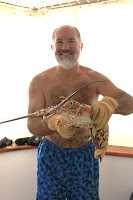We had a nice passage to LasTortugas and the Captain caught a Mahi-Mahi. These fish are also

called Dolphin (not the Flipper variety) and are an iridescent blue and yellow. They loose their color almost immediately when brought into the boat and we all watched it change before our eyes. In the photo the color is receding from the mouth towards the tail and is about half gone. Kim used up the last of our Nori paper making sushi and we had enough meat for several dinners. Kim made soup with the bones and head and nothing went to waste. It was simply delicious.
Tortugas was clean with white powder sand beaches and few other people. We walked the beaches and did some snorkeling in the afternoons after homeschool and it was a peaceful stay.
We headed Northwest towards Los Roques and hooked a Little Tunny on the way.
It was good for a few dinners but never made it into a sushi roll. The Los Roques islands are a federal dependency of Venezuela, consisting of about 350 islands, cays or islets. The archipelago is an atoll and because of the wide variety of seabirds and rich aquatic life, the Venezuelan government declared Los Roques a National Park in 1972. We anchored off several of the individual islands and behind some barrier reefs. It was amazing to be anchored in calm light blue water and 50 yards ahead of us we could hear the crashing of waves against the reef that was protecting us. We snorkelled at each spot and saw turtles and many fish that were unafraid of us because they are protected within the park.
We headed westward toward The Aves. Las Aves is a pristine archipelago and is part of the Federal Dependencies of Venezuela. Just before making landfall, the Captain hooked a White Marlin. We brought it up to the side of the boat and managed a quick video before it made a quick flick of its sword and slashed the 80 lb leader like butter. We lost the lure but we enjoyed the fight and that magnificent fish will live to fight another day.
We dressed ship (put up special colored flags) for Emily's 9th Birthday. Kim baked a chocolate layer cake and we had Wiro and Esther from
de Swerver over to celebrate with us.
De Swerver hails from Belgium
and they have been nice to travel with. Apparently we had enough gifts since Emily was in her glory.
She was invited alone to help sail
de Swerver between islands on a 2 hour sail and got to steer and trim the sails.
The archipelago consists of two atoll-like reef complexes. We spent 2 days at Aves de Barlovento, the eastern group and moved west to Aves de Sotavento for 2 more days. The water here was also clear but strong winds made snorkelling a little too rough. There are large colonies of booby birds including the Red-Footed booby that have beautiful blue bills. Several fluffy babby boobies were watching us from their mangrove nests.
We had a pot luck dinner aboard
Emily Grace one evening with the crew of
de Swerver and Ray and Genna aboard
NightHawk.
NightHawk brought some blackfin tuna they had caught and we shared some Mahi Mahi and
de Swerver shared some wonderful homemade dutch dishes. The wine flowed and my 3 A/C units ran to keep the boat cool and comfortable.
We were keeping track of the weather through our single sideband radio and were anxious to make our next landfall. Only 40 miles to the west lay Bonaire, where Kim and I had spent several winter vacations escaping the New England cold and enjoying the world class SCUBA diving. We could hardly wait to see it again….
Tom


































